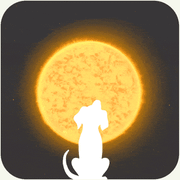How One of Science’s Biggest Errors Persisted for 1,500 Years
Ptolemy’s compendium, later known as the Almagest, dominated Western astronomy for 15 centuries. It was also wrong, and it took the fall of an empire to fix it.

A basic understanding of the solar system is something we take for granted today, but Western science had things wrong for some 1,500 years. Blame the Moon, and blame a man named Claudius Ptolemy.
Around the year 150, the Roman Alexandrian scholar wrote a massive compendium of ancient math later (and famously) called the Almagest. It was a stunning achievement, and laid the mathematical foundations for an Earth-centric universe. It also set everyone from Constantinople to Krakow on the wrong path. Sorting it all out took the fall of the Byzantine Empire, a refugee scholar, an overzealous translator, and a detail-oriented Pole named Copernicus. The journey through history, math, and physics is convoluted, but worth it, so buckle in for the tale of one of science’s oldest and biggest errors.
First, consider an obvious fact: The Moon goes around the Earth. Watch as the Moon cycles through a month, and you can tell that it is lit by the Sun, and that its appearance changes as it goes around our world. This could be one reason why humanity believed in geocentrism in the first place. If it’s clear that the Moon revolves around Earth, then it’s logical to imagine that everything else does, too. Why would the universe be arranged in any other way? Moreover, how would solar eclipses work, if the Sun and the Moon didn’t follow a similar path around our planet?
Most people throughout antiquity were certain the Sun orbited the Earth. It made sense, and that was that. Claudius Ptolemy was the first person to come up with complicated physics that could explain just how this arrangement would work. With the great library of Alexandria at his disposal, he distilled the collected knowledge of Greece, Egypt, Babylon, and Rome into a treatise full of numerical tables, data sets, and his own interpretations. He called it Mathematical Arrangement. The name Almagest comes from an Arabic translation calling it “the greatest compilation.”
Using astronomical records, Ptolemy invented a scheme for how the Sun, the other planets, and the Moon could all orbit the Earth. It involved epicycles, which are convoluted circles-within-circles.

However, our Moon didn’t quite fit his model. Ptolemy suggested that its orbital path must be tilted with respect to the other heavenly bodies, but problems remained. His math suggests that the Moon’s size would change dramatically throughout the month. Like epicycles themselves, this is not a thing. Yet Ptolemy’s complicated, bizarre system stood for 15 centuries as the textbook for cosmology because it seemed to work, or at least work well enough.
Ptolemy wrote in Greek, but centuries after he published it, Almagest was translated into Arabic. Some Islamic Arab scholars openly doubted Ptolemy’s conclusions, but no one really challenged his complex mathematical proofs, and people in the Western, Christian world were mostly comfortable believing that we humans were the center of the universe.
Around the middle of the 12th century, a scholar working in the Arab court of Toledo produced the first Arabic-to-Latin translation of Almagest. His name was Gerard of Cremona, and he remains one of the world’s most important translators of ancient texts. According to a 2023 paper published in the Journal for the History of Astronomy, Gerard may have tried to fix some of Ptolemy’s math. In doing so, it appears that he helped perpetuate antiquity’s grand error—that the Sun orbits the Earth—at least for a few more centuries.
The paper’s author, Stefan Zieme of Humboldt University in Berlin, examined some texts Gerard used for his translations, and found that some of the numbers weren’t matching up among the Latin, Greek, and Arabic versions. The corrections were both minor and major, and ranged from declination values, which describe the positions of stars and planets in the sky, to rising times, vital for casting accurate horoscopes.
Gerard’s attempted corrections may have made it easier for readers to accept Ptolemy’s unusual, obtuse, and occasionally mismatched numbers. Perhaps this made it even easier to accept geocentrism, too.
Gerard’s translation made the rounds in Europe during the medieval period, and was copied multiple times. Then came the fall of Constantinople, and the beginning of the end for Ptolemy’s convoluted Earth-centric cosmology.

After the invading Turkish Army took Constantinople in May 1453, the Greek-speaking world drained out of the remains of the Byzantine Empire. Refugee scholars salvaged their texts and translations of works from antiquity. In 1460, one of these men, a cardinal named Basilios Bessarion, arrived in Vienna, carrying a copy of Ptolemy’s Mathematical Arrangement in the original Greek.
In Vienna, Bessarion met a scholar named Regiomontanus, who produced a fresh Latin translation of Ptolemy’s seminal work to be used for teaching. It was the first edition produced on a printing press. Like many students’ textbooks, this new version, called the Epitome of the Almagest, included a reader’s guide with interpretations from the translators. Central among the critiques that Regiomontanus included in the guide: Ptolemy was wrong about the Moon.
In 1491, a university student named Nicolaus Copernicus read a copy of the Epitome of the Almagest and also doubted some of Ptolemy’s elaborate explanations. You probably know what happened next.
Copernicus measured eclipses and relied on observations of our satellite to develop his new, accurate worldview: The Moon orbits Earth, yes, but Earth orbits the Sun, and so do all the other planets.
Copernicus, Regiomontanus, and Ptolemy himself would have looked forward to April’s total solar eclipse with great interest. To see the Moon cross in front of our star, blocking all but its outer atmosphere, is one of the most unusual, terrifying, beautiful experiences we can have on this planet. And it is a wondrous way to witness, and to study, the movement of the heavenly bodies.
We now know that the Moon blocks the Sun during total eclipses because of an astonishing cosmic coincidence, no epicycles needed. Thanks to a mathematical fluke, the much larger but much more distant Sun appears to be the same size in the sky as the Moon, and the two bodies seem to cross paths overhead now and then. This random accident of geometry never ceases to astound me. It’s almost enough to make me reach for Ptolemy, seeking a mathematically grounded arrangement, one designed by providence, even, and not just by chance.
Wondersky columnist Rebecca Boyle is the author of Our Moon: How Earth’s Celestial Companion Transformed the Planet, Guided Evolution, and Made Us Who We Are (January 2024, Random House). She is a featured speaker at Atlas Obscura’s Ecliptic Festival, April 5-8, 2024, in Hot Springs, Ark.




















Follow us on Twitter to get the latest on the world's hidden wonders.
Like us on Facebook to get the latest on the world's hidden wonders.
Follow us on Twitter Like us on Facebook